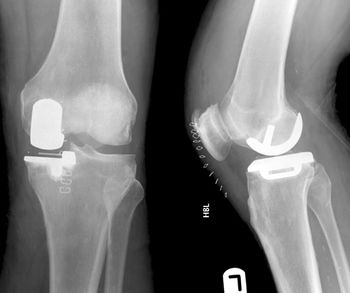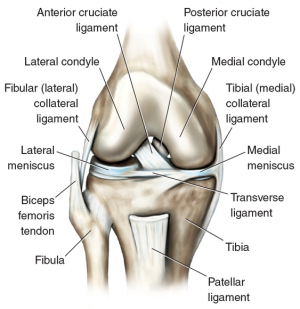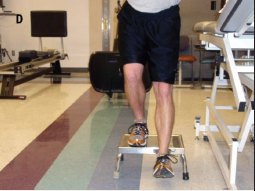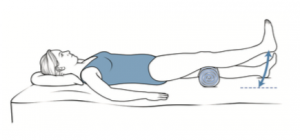Partial Knee Replacement: Difference between revisions
No edit summary |
No edit summary |
||
| (6 intermediate revisions by 2 users not shown) | |||
| Line 5: | Line 5: | ||
</div> | </div> | ||
== Description == | == Description == | ||
[[File:Pic tkr 04 big.jpg| | [[File:Pic tkr 04 big.jpg|350x350px|right|frameless]] | ||
A partial knee replacement (PKR) is a surgical procedure to replace only one part of a damaged [[knee]]. It can replace either the | A partial knee replacement (PKR) is a surgical procedure to replace only one part of a damaged [[knee]]. It can replace either the medial part, the lateral part, or the [[patella]] of the knee. | ||
* Partial knee replacement has several advantages over total knee replacement, including shorter recovery time and more range of motion preserved after surgery. But partial knee replacement is only an option for people with knee damage in just one place, either lateral, medial or the patella<ref name=":0">Health grades PKR Available from:https://www.healthgrades.com/right-care/knee-replacement/partial-knee-replacement (accessed 17.2.2021)</ref>. | |||
* Surgery to replace the whole knee joint is called [https://www.physio-pedia.com/Total_knee_arthroplasty total knee replacement.] | |||
Surgery to replace the whole knee joint is called [https://www.physio-pedia.com/Total_knee_arthroplasty total knee replacement.] | |||
== Indication == | == Indication == | ||
[[File:Structures of the knee.png|right|frameless]] | |||
The most common reason for partial knee replacement is single-compartmental knee damage from advanced [[Knee Osteoarthritis|osteoarthritis]]<ref name=":0" /> | |||
Partial Knee Replacement is | Partial Knee Replacement is also used for used in individuals with joint disease resulting from [[Rheumatoid Arthritis|Rheumatoid]]<nowiki/>aArthritis,[[post-traumatic arthritis|ost-traumatic arthritis]], and for moderate deformity of the Knee. | ||
Partial knee replacement surgery improves pain and function similarly to total knee replacement in people with osteoarthritis that affects only a single compartment of the knee. Partial knee replacement surgery is also cheaper.<ref>NIHR [https://evidence.nihr.ac.uk/alert/partial-knee-replacement-could-be-first-choice-for-suitable-patients-with-osteoarthritis/ PKR] Available from: https://evidence.nihr.ac.uk/alert/partial-knee-replacement-could-be-first-choice-for-suitable-patients-with-osteoarthritis/ (accessed 17.2.2021)</ref> | |||
== Diagnostic Tests == | == Diagnostic Tests == | ||
# [[X-Rays|X-rays]]. These images help to determine the extent of damage and deformity of the knee. Several x-rays of the knee are taken to see the pattern of arthritis. | |||
X- | # [[MRI Scans|Magnetic resonance imaging]] (MRI) scans. Some surgeons may also order an MRI scan to better evaluate the cartilage<ref name=":1">Orthoinfo [https://orthoinfo.aaos.org/en/treatment/unicompartmental-knee-replacement UKR] Available from: https://orthoinfo.aaos.org/en/treatment/unicompartmental-knee-replacement (accessed 17.2.2021)</ref>. | ||
== Surgical Procedure & Types of Partial Knee Replacement == | == Surgical Procedure & Types of Partial Knee Replacement == | ||
| Line 44: | Line 35: | ||
Pre-operative preparation begins immediately following surgical consultation and lasts approximately one month. | Pre-operative preparation begins immediately following surgical consultation and lasts approximately one month. | ||
The patient | The patient performs range of motion exercises and hip, knee and ankle strengthening (Isometrics) as instructed by Therapist. | ||
{{#ev:youtube|bOhuY4nBKpw}} | {{#ev:youtube|bOhuY4nBKpw}} | ||
Before the surgery is performed, pre-operative tests are done: usually a complete blood count, electrolytes, APTT and PT to measure blood clotting, chest X-rays, [[Electrocardiogram]], and blood cross-matching for possible transfusion. | Before the surgery is performed, pre-operative tests are done: usually a complete blood count, electrolytes, APTT and PT to measure blood clotting, chest X-rays, [[Electrocardiogram]], and [[Blood Physiology|blood]] cross-matching for possible transfusion. | ||
* About a month before the surgery, the patient may be prescribed supplemental iron to boost the hemoglobin in their blood system. | |||
* Accurate X-rays of the affected knee are needed to measure the size of components which will be needed. Medications such as warfarin and aspirin will be stopped some days before surgery to reduce the amount of bleeding. | |||
* Patients may be admitted on the day of surgery if the pre-op work-up is done in the pre-anesthetic clinic or may come into hospital one or more days before surgery. Some hospitals offer a pre-operative seminar<ref>Before surgery, your orthopaedic surgeon will make some recommendations, such as suggesting that you: Donate some of your own blood so that, if needed, you may receive it during or after surgery Stop taking some drugs before surgery. http://www.vims.ac.in/healthcare/joint-replace-recovery-process.html</ref> for this surgery. | |||
* Preoperative education is currently an important part of patient care. There is some evidence that it may slightly reduce anxiety before knee replacement surgery, with low risk of detrimental effects.<ref>McDonald, S; Page, MJ; Beringer, K; Wasiak, J; Sprowson, A (13 May 2014). "Preoperative education for hip or knee replacement". The Cochrane Database of Systematic Reviews (5): CD003526. doi:10.1002/14651858.CD003526.pub3. PMID 24820247.</ref> Currently there is insufficient quality evidence to support the use of pre-operative physiotherapy in older adults undergoing total knee arthroplasty<ref>Chesham, Ross Alexander; Shanmugam, Sivaramkumar (13 October 2016). "Does preoperative physiotherapy improve postoperative, patient-based outcomes in older adults who have undergone total knee arthroplasty? A systematic review". Physiotherapy Theory and Practice: 1–22. doi:10.1080/09593985.2016.1230660. PMID 27736286.</ref> | |||
* Weight loss surgery before a knee replacement does not appear to change outcomes.<ref>Smith, TO; Aboelmagd, T; Hing, CB; MacGregor, A (September 2016). "Does bariatric surgery prior to total hip or knee arthroplasty reduce post-operative complications and improve clinical outcomes for obese patients? Systematic review and meta-analysis.". The bone & joint journal. 98–B (9): 1160–6. doi:10.1302/0301-620x.98b9.38024. PMID 27587514.</ref> | |||
== Physiotherapy Rehabilitation == | |||
[[File:Hip exercise 6.png|right|frameless]] | |||
Rehabilitation exercise: given to help maintain range of motion and restore strength. Exercises are as for total knee arthroplasty, see [[Total Knee Arthroplasty|here]]. | |||
== Hospital discharge. == | |||
Partial knee replacement patients usually experience less postoperative pain, less swelling, and have easier rehabilitation than patients undergoing total knee replacement. In most cases, patients go home 1 to 3 days after the operation. Some patients go home the day of the surgery<ref name=":1" /> (depending on the health status of the patient and the amount of support available outside the hospital setting).<ref>Carter, Evelene M; Potts, Henry WW (2014). "Predicting length of stay from an electronic patient record system: a primary total knee replacement example". BMC Medical Informatics and Decision Making. 14 (1): 26. doi:10.1186/1472-6947-14-26. ISSN 1472-6947.</ref> Protected weight bearing on crutches or a walker is required until specified by the surgeon <ref>"Rehabilitation" (PDF). massgeneral.org.</ref> because of weakness in the quadriceps muscle<ref>Valtonen, Anu; Pöyhönen, Tapani; Heinonen, Ari; Sipilä, Sarianna (2009-10-01). "Muscle Deficits Persist After Unilateral Knee Replacement and Have Implications for Rehabilitation". Physical Therapy. 89 (10): 1072–1079. doi:10.2522/ptj.20070295. ISSN 0031-9023. PMID 19713269.</ref> | |||
To increase the likelihood of a good outcome after surgery, multiple weeks of physical therapy is necessary. In these weeks, the therapist will help the patient return to normal activities, as well as prevent blood clots, improve circulation, increase range of motion, and eventually strengthen the surrounding muscles through specific exercises. | |||
To increase the likelihood of a good outcome after surgery, multiple weeks of physical therapy is necessary. In these weeks, the therapist will help the patient return to normal activities, as well as prevent blood clots,improve circulation,increase range of motion,and eventually strengthen the surrounding muscles through specific exercises. | |||
{{#ev:youtube|WdS7E141z4s}} | {{#ev:youtube|WdS7E141z4s}} | ||
=== Week 1 | == Protocol Physiotherapy Rehabilitation == | ||
Goals | [[File:Extension of the knee lying.png|right|frameless]] | ||
'''Week 1:''' Goals | |||
* Decrease pain/swelling. | * Decrease pain/swelling. | ||
* Passive range of motion <90 | * Passive range of motion <90 degrees (secondary to stitches) x 2 weeks. | ||
* Full weight bearing. | * Full weight bearing. | ||
'''Week 2 - 4:''' Goals | |||
Goals | |||
* Decrease pain/swelling. | * Decrease pain/swelling. | ||
* Tolerate bilateral stationary cycling. | * Tolerate bilateral stationary cycling. | ||
* Active range of motion 0-90 degrees. | * Active range of motion 0-90 degrees. | ||
'''Week 4 - 6:''' Goals | |||
Goals | |||
* Normal gait pattern. | * Normal gait pattern. | ||
'''Week 6 - 8:''' Goals | |||
Goals | |||
* Active range of motion 0 to 110 degrees. | * Active range of motion 0 to 110 degrees. | ||
* Passive range of motion 120 degrees. | * Passive range of motion 120 degrees. | ||
'''Week 8 - 12:''' Goals | |||
* Walk downstairs with reciprocal gait. | |||
Goals | |||
* Walk downstairs with reciprocal | |||
* Full range of motion.<ref>Robotic-joint-center .“Unicompartmental (partial knee) replacement rehab protocol. ” available on <nowiki>http://www.stoneclinic.com</nowiki> | * Full range of motion.<ref>Robotic-joint-center .“Unicompartmental (partial knee) replacement rehab protocol. ” available on <nowiki>http://www.stoneclinic.com</nowiki> | ||
</ref> | </ref> | ||
Treatment includes encouraging patients to move early after the surgery. <ref>American Physical Therapy Association (15 September 2014), "Five Things Physicians and Patients Should Question", Choosing Wisely: an initiative of the ABIM Foundation, American Physical Therapy Association, retrieved 15 September 2014, which citesfckLRfckLR Harvey, LA; Brosseau, L; Herbert, RD (Mar 17, 2010). "Continuous passive motion following total knee arthroplasty in people with arthritis.". Cochrane database of systematic reviews (Online) (3): CD004260. doi:10.1002/14651858.CD004260.pub2. PMID 20238330.</ref> Often range of motion (to the limits of the prosthesis) is recovered over the first two weeks (the earlier the better). Over time, patients are able to increase the amount of weight bearing on the operated leg, and eventually are able to tolerate full weight bearing with the guidance of the physical therapist. After about ten months, the patient should be able to return to normal daily activities, although the operated leg may be significantly weaker than the non-operated leg.<ref>Valtonen, Anu; Pöyhönen, Tapani; Heinonen, Ari; Sipilä, Sarianna (2009-10-01). "Muscle Deficits Persist After Unilateral Knee Replacement and Have Implications for Rehabilitation". Physical Therapy. 89 (10): 1072–1079. doi:10.2522/ptj.20070295. ISSN 0031-9023. PMID 19713269.</ref> | Treatment includes encouraging patients to move early after the surgery. <ref>American Physical Therapy Association (15 September 2014), "Five Things Physicians and Patients Should Question", Choosing Wisely: an initiative of the ABIM Foundation, American Physical Therapy Association, retrieved 15 September 2014, which citesfckLRfckLR Harvey, LA; Brosseau, L; Herbert, RD (Mar 17, 2010). "Continuous passive motion following total knee arthroplasty in people with arthritis.". Cochrane database of systematic reviews (Online) (3): CD004260. doi:10.1002/14651858.CD004260.pub2. PMID 20238330.</ref> Often range of motion (to the limits of the prosthesis) is recovered over the first two weeks (the earlier the better). Over time, patients are able to increase the amount of weight bearing on the operated leg, and eventually are able to tolerate full weight bearing with the guidance of the physical therapist. | ||
* After about ten months, the patient should be able to return to normal daily activities, although the operated leg may be significantly weaker than the non-operated leg.<ref>Valtonen, Anu; Pöyhönen, Tapani; Heinonen, Ari; Sipilä, Sarianna (2009-10-01). "Muscle Deficits Persist After Unilateral Knee Replacement and Have Implications for Rehabilitation". Physical Therapy. 89 (10): 1072–1079. doi:10.2522/ptj.20070295. ISSN 0031-9023. PMID 19713269.</ref> | |||
For knee replacement without complications, continuous passive motion (CPM) can improve recovery. <ref>American Physical Therapy Association (15 September 2014), "Five Things Physicians and Patients Should Question", Choosing Wisely: an initiative of the ABIM Foundation, American Physical Therapy Association, retrieved 15 September 2014, which citesfckLRfckLR Harvey, LA; Brosseau, L; Herbert, RD (Mar 17, 2010). "Continuous passive motion following total knee arthroplasty in people with arthritis.". Cochrane database of systematic reviews (Online) (3): CD004260. doi:10.1002/14651858.CD004260.pub2. PMID 20238330.</ref>Additionally, CPM is inexpensive, convenient, and assists patients in therapeutic compliance. However, CPM should be used in conjunction with traditional physical therapy. In unusual cases where the person has a problem which prevents standard mobilization treatment, then CPM may be useful. | For knee replacement without complications, continuous passive motion (CPM) can improve recovery. <ref>American Physical Therapy Association (15 September 2014), "Five Things Physicians and Patients Should Question", Choosing Wisely: an initiative of the ABIM Foundation, American Physical Therapy Association, retrieved 15 September 2014, which citesfckLRfckLR Harvey, LA; Brosseau, L; Herbert, RD (Mar 17, 2010). "Continuous passive motion following total knee arthroplasty in people with arthritis.". Cochrane database of systematic reviews (Online) (3): CD004260. doi:10.1002/14651858.CD004260.pub2. PMID 20238330.</ref>Additionally, CPM is inexpensive, convenient, and assists patients in therapeutic compliance. However, CPM should be used in conjunction with traditional physical therapy. In unusual cases where the person has a problem which prevents standard mobilization treatment, then CPM may be useful. | ||
== Contra-indications & Common Side-Effects Key Evidence == | == Contra-indications & Common Side-Effects Key Evidence == | ||
| Line 110: | Line 96: | ||
[[Category:Older People/Geriatrics - Conditions]] | [[Category:Older People/Geriatrics - Conditions]] | ||
[[Category:Older People/Geriatrics - Interventions]] | [[Category:Older People/Geriatrics - Interventions]] | ||
[[Category:Osteoarthritis]] | |||
[[Category:Arthroplasty]] | |||
Latest revision as of 13:55, 11 January 2024
Original Editor - Venugopal Pawar
Top Contributors - Venugopal Pawar, Ahmed Nassef, Kim Jackson, Lucinda hampton, 127.0.0.1, Admin, Selena Horner, George Prudden, WikiSysop, Leana Louw and Lauren Lopez
Description[edit | edit source]
A partial knee replacement (PKR) is a surgical procedure to replace only one part of a damaged knee. It can replace either the medial part, the lateral part, or the patella of the knee.
- Partial knee replacement has several advantages over total knee replacement, including shorter recovery time and more range of motion preserved after surgery. But partial knee replacement is only an option for people with knee damage in just one place, either lateral, medial or the patella[1].
- Surgery to replace the whole knee joint is called total knee replacement.
Indication[edit | edit source]
The most common reason for partial knee replacement is single-compartmental knee damage from advanced osteoarthritis[1]
Partial Knee Replacement is also used for used in individuals with joint disease resulting from RheumatoidaArthritis,ost-traumatic arthritis, and for moderate deformity of the Knee.
Partial knee replacement surgery improves pain and function similarly to total knee replacement in people with osteoarthritis that affects only a single compartment of the knee. Partial knee replacement surgery is also cheaper.[2]
Diagnostic Tests[edit | edit source]
- X-rays. These images help to determine the extent of damage and deformity of the knee. Several x-rays of the knee are taken to see the pattern of arthritis.
- Magnetic resonance imaging (MRI) scans. Some surgeons may also order an MRI scan to better evaluate the cartilage[3].
Surgical Procedure & Types of Partial Knee Replacement[edit | edit source]
Types[edit | edit source]
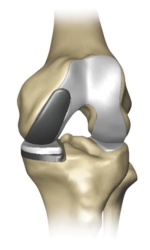
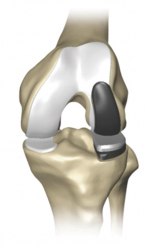 Unicondylar Knee Replacement is a procedure that replaces only the single affected compartment of the knee, either the medial or lateral compartment.
Unicondylar Knee Replacement is a procedure that replaces only the single affected compartment of the knee, either the medial or lateral compartment.
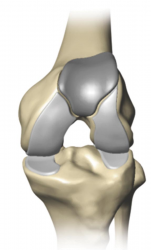 Patellofemoral Knee Replacement is a procedure that replaces the worn patella (the kneecap) and the trochlea (the groove at the end of the thighbone).
Patellofemoral Knee Replacement is a procedure that replaces the worn patella (the kneecap) and the trochlea (the groove at the end of the thighbone).
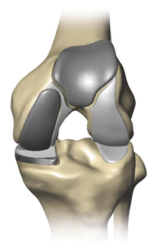 Bicompartmental Knee Replacement is a procedure that replaces two compartments of the knee, the medial and patellofemoral compartments.
Bicompartmental Knee Replacement is a procedure that replaces two compartments of the knee, the medial and patellofemoral compartments.
Pre-operative Preparation[edit | edit source]
Pre-operative preparation begins immediately following surgical consultation and lasts approximately one month.
The patient performs range of motion exercises and hip, knee and ankle strengthening (Isometrics) as instructed by Therapist.
Before the surgery is performed, pre-operative tests are done: usually a complete blood count, electrolytes, APTT and PT to measure blood clotting, chest X-rays, Electrocardiogram, and blood cross-matching for possible transfusion.
- About a month before the surgery, the patient may be prescribed supplemental iron to boost the hemoglobin in their blood system.
- Accurate X-rays of the affected knee are needed to measure the size of components which will be needed. Medications such as warfarin and aspirin will be stopped some days before surgery to reduce the amount of bleeding.
- Patients may be admitted on the day of surgery if the pre-op work-up is done in the pre-anesthetic clinic or may come into hospital one or more days before surgery. Some hospitals offer a pre-operative seminar[4] for this surgery.
- Preoperative education is currently an important part of patient care. There is some evidence that it may slightly reduce anxiety before knee replacement surgery, with low risk of detrimental effects.[5] Currently there is insufficient quality evidence to support the use of pre-operative physiotherapy in older adults undergoing total knee arthroplasty[6]
- Weight loss surgery before a knee replacement does not appear to change outcomes.[7]
Physiotherapy Rehabilitation[edit | edit source]
Rehabilitation exercise: given to help maintain range of motion and restore strength. Exercises are as for total knee arthroplasty, see here.
Hospital discharge.[edit | edit source]
Partial knee replacement patients usually experience less postoperative pain, less swelling, and have easier rehabilitation than patients undergoing total knee replacement. In most cases, patients go home 1 to 3 days after the operation. Some patients go home the day of the surgery[3] (depending on the health status of the patient and the amount of support available outside the hospital setting).[8] Protected weight bearing on crutches or a walker is required until specified by the surgeon [9] because of weakness in the quadriceps muscle[10]
To increase the likelihood of a good outcome after surgery, multiple weeks of physical therapy is necessary. In these weeks, the therapist will help the patient return to normal activities, as well as prevent blood clots, improve circulation, increase range of motion, and eventually strengthen the surrounding muscles through specific exercises.
Protocol Physiotherapy Rehabilitation[edit | edit source]
Week 1: Goals
- Decrease pain/swelling.
- Passive range of motion <90 degrees (secondary to stitches) x 2 weeks.
- Full weight bearing.
Week 2 - 4: Goals
- Decrease pain/swelling.
- Tolerate bilateral stationary cycling.
- Active range of motion 0-90 degrees.
Week 4 - 6: Goals
- Normal gait pattern.
Week 6 - 8: Goals
- Active range of motion 0 to 110 degrees.
- Passive range of motion 120 degrees.
Week 8 - 12: Goals
- Walk downstairs with reciprocal gait.
- Full range of motion.[11]
Treatment includes encouraging patients to move early after the surgery. [12] Often range of motion (to the limits of the prosthesis) is recovered over the first two weeks (the earlier the better). Over time, patients are able to increase the amount of weight bearing on the operated leg, and eventually are able to tolerate full weight bearing with the guidance of the physical therapist.
- After about ten months, the patient should be able to return to normal daily activities, although the operated leg may be significantly weaker than the non-operated leg.[13]
For knee replacement without complications, continuous passive motion (CPM) can improve recovery. [14]Additionally, CPM is inexpensive, convenient, and assists patients in therapeutic compliance. However, CPM should be used in conjunction with traditional physical therapy. In unusual cases where the person has a problem which prevents standard mobilization treatment, then CPM may be useful.
Contra-indications & Common Side-Effects Key Evidence[edit | edit source]
- Some physicians and patients may consider having lower limbs venous ultrasonography to screen for deep vein thrombosis after knee replacement.However, this kind of screening should be done only when indicated. If a medical condition exists that could cause deep vein thrombosis, a physician can choose to treat patients with cryotherapy and intermittent pneumatic compression as a preventive measure.[15]
- Partial Knee Replacement surgery is not appropriate for patients with certain types of Infections, any mental or neuromuscular disorder which would create an unacceptable risk of prosthesis instability, prosthesis fixation failure or complication in postoperative care, skeletal immaturity, severe instability of the knee or Excessive body weight.
- Common side effects:as with any surgery, PKR has its risks which may be Implant related risks which may lead to a revision include dislocation, loosening, fracture, nerve damage, heterotropic ossification, wear of the implant, metal sensitivity, soft tissue imbalance, osteolysis (localized progressive bone loss) and reaction to particle debris.
- Knee implants may not provide the same feel or performance characteristics experienced with a normal healthy joint.
References[edit | edit source]
- ↑ 1.0 1.1 Health grades PKR Available from:https://www.healthgrades.com/right-care/knee-replacement/partial-knee-replacement (accessed 17.2.2021)
- ↑ NIHR PKR Available from: https://evidence.nihr.ac.uk/alert/partial-knee-replacement-could-be-first-choice-for-suitable-patients-with-osteoarthritis/ (accessed 17.2.2021)
- ↑ 3.0 3.1 Orthoinfo UKR Available from: https://orthoinfo.aaos.org/en/treatment/unicompartmental-knee-replacement (accessed 17.2.2021)
- ↑ Before surgery, your orthopaedic surgeon will make some recommendations, such as suggesting that you: Donate some of your own blood so that, if needed, you may receive it during or after surgery Stop taking some drugs before surgery. http://www.vims.ac.in/healthcare/joint-replace-recovery-process.html
- ↑ McDonald, S; Page, MJ; Beringer, K; Wasiak, J; Sprowson, A (13 May 2014). "Preoperative education for hip or knee replacement". The Cochrane Database of Systematic Reviews (5): CD003526. doi:10.1002/14651858.CD003526.pub3. PMID 24820247.
- ↑ Chesham, Ross Alexander; Shanmugam, Sivaramkumar (13 October 2016). "Does preoperative physiotherapy improve postoperative, patient-based outcomes in older adults who have undergone total knee arthroplasty? A systematic review". Physiotherapy Theory and Practice: 1–22. doi:10.1080/09593985.2016.1230660. PMID 27736286.
- ↑ Smith, TO; Aboelmagd, T; Hing, CB; MacGregor, A (September 2016). "Does bariatric surgery prior to total hip or knee arthroplasty reduce post-operative complications and improve clinical outcomes for obese patients? Systematic review and meta-analysis.". The bone & joint journal. 98–B (9): 1160–6. doi:10.1302/0301-620x.98b9.38024. PMID 27587514.
- ↑ Carter, Evelene M; Potts, Henry WW (2014). "Predicting length of stay from an electronic patient record system: a primary total knee replacement example". BMC Medical Informatics and Decision Making. 14 (1): 26. doi:10.1186/1472-6947-14-26. ISSN 1472-6947.
- ↑ "Rehabilitation" (PDF). massgeneral.org.
- ↑ Valtonen, Anu; Pöyhönen, Tapani; Heinonen, Ari; Sipilä, Sarianna (2009-10-01). "Muscle Deficits Persist After Unilateral Knee Replacement and Have Implications for Rehabilitation". Physical Therapy. 89 (10): 1072–1079. doi:10.2522/ptj.20070295. ISSN 0031-9023. PMID 19713269.
- ↑ Robotic-joint-center .“Unicompartmental (partial knee) replacement rehab protocol. ” available on http://www.stoneclinic.com
- ↑ American Physical Therapy Association (15 September 2014), "Five Things Physicians and Patients Should Question", Choosing Wisely: an initiative of the ABIM Foundation, American Physical Therapy Association, retrieved 15 September 2014, which citesfckLRfckLR Harvey, LA; Brosseau, L; Herbert, RD (Mar 17, 2010). "Continuous passive motion following total knee arthroplasty in people with arthritis.". Cochrane database of systematic reviews (Online) (3): CD004260. doi:10.1002/14651858.CD004260.pub2. PMID 20238330.
- ↑ Valtonen, Anu; Pöyhönen, Tapani; Heinonen, Ari; Sipilä, Sarianna (2009-10-01). "Muscle Deficits Persist After Unilateral Knee Replacement and Have Implications for Rehabilitation". Physical Therapy. 89 (10): 1072–1079. doi:10.2522/ptj.20070295. ISSN 0031-9023. PMID 19713269.
- ↑ American Physical Therapy Association (15 September 2014), "Five Things Physicians and Patients Should Question", Choosing Wisely: an initiative of the ABIM Foundation, American Physical Therapy Association, retrieved 15 September 2014, which citesfckLRfckLR Harvey, LA; Brosseau, L; Herbert, RD (Mar 17, 2010). "Continuous passive motion following total knee arthroplasty in people with arthritis.". Cochrane database of systematic reviews (Online) (3): CD004260. doi:10.1002/14651858.CD004260.pub2. PMID 20238330.
- ↑ Dallan C. Manscill (June 16, 2015). "Intermittent Pneumatic Compression and Treating Deep Vein Thrombosis & Pulmonary Embolism".
